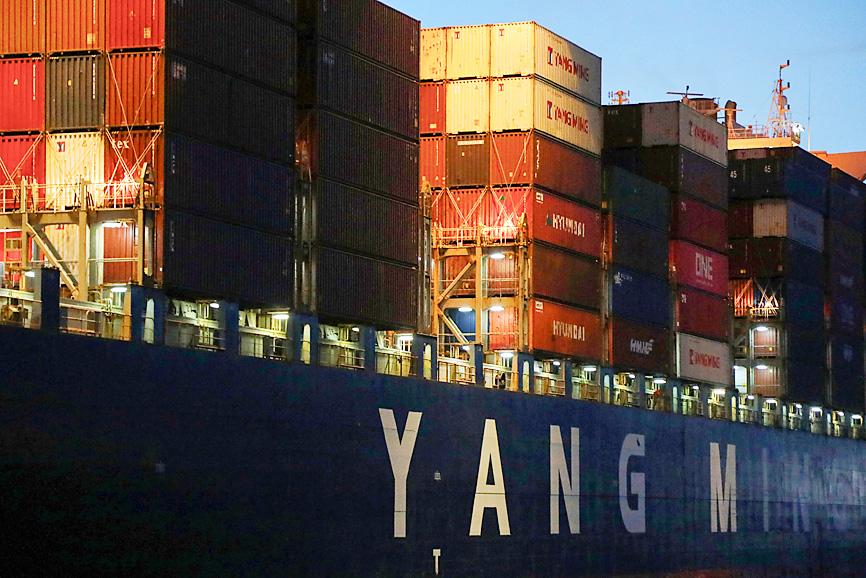Yang Ming Marine Transport Corp (陽明海運) shares rose 33.91 percent last week, ending at their highest level in nine years on Friday, buoyed by better-than-expected profit last month.
The container shipper reported that net profit last month increased 739.48 percent year-on-year to NT$2.71 billion (US$95 million), which was almost as much as the NT$2.74 billion profit it made in the third quarter, Yang Ming said in a regulatory filing on Thursday.
Earnings per share were NT$0.92 last month, compared with NT$1.05 last quarter, while revenue reached NT$15.27 billion, up 29 percent from a year earlier, the company said.

Photo: Ann Wang, Reuters
Yang Ming shares rose 10 percent, the daily maximum, on Friday to close at NT$23.1, the highest since June 2011, Taiwan Stock Exchange data showed. So far this year, they have surged 220.4 percent.
Capital Investment Management Corp (群益投顧) on Friday retained its “buy” rating on the stock, with a target price of NT$25, as the container shipping sector’s supply-demand dynamics and order outlook are moving in positive directions, it said.
Yang Ming posted net losses of NT$818.36 million in the first quarter and NT$67.53 million in the second quarter, but the company turned profitable in the third quarter on the back of rising freight rates as demand for inventory replenishment bolstered freight volume, while shortfalls in labor and truck-trailer chassis due to the COVID-19 pandemic drive a container shortage.
Container shippers and sea transport companies are experiencing a once-in-a-century boom this year, driven by household product demand from the stay-at-home economy amid the pandemic and a shift to spending more on consumer products due to travel restrictions, analysts said.
While the container shortage has boosted freight rates on European routes, China’s removal of restrictions on freight rate hikes for US routes might cause rates to rise further in the short term to support shippers’ earnings, they said.
“Due to a surge in new infections, many governments have reimplemented lockdowns. Congestion at ports and higher demand for life necessities and healthcare supplies have caused shipping capacity to remain relatively tight,” Capital said in a research note.
“In addition, freight load factors of various routes have remained at 100 percent, which have in turn persistently boosted the freight rates of European routes to new highs,” it said.
In the year to date, freight rates on European routes have increased by 202.4 percent, while rates on US east and west coast routes have grown by 90.2 percent and 172 percent respectively, according to data compiled by Capital.
Yang Ming’s revenue this quarter should stay robust due to demand for inventory replenishment of household and consumer products, as well as the persistent container shortage, while fourth-quarter profit is estimated to increase to NT$6.66 billion, or earnings per share of NT$2.54, Capital said.
The company’s profit for this year would likely hit a 10-year high, as Capital forecast net profit of NT$8.51 billion, or earnings per share of NT$2.91.

SEMICONDUCTORS: The firm has already completed one fab, which is to begin mass producing 2-nanomater chips next year, while two others are under construction Taiwan Semiconductor Manufacturing Co (TSMC, 台積電), the world’s largest contract chipmaker, plans to begin construction of its fourth and fifth wafer fabs in Kaohsiung next year, targeting the development of high-end processes. The two facilities — P4 and P5 — are part of TSMC’s production expansion program, which aims to build five fabs in Kaohsiung. TSMC facility division vice president Arthur Chuang (莊子壽) on Thursday said that the five facilities are expected to create 8,000 jobs. To respond to the fast-changing global semiconductor industry and escalating international competition, TSMC said it has to keep growing by expanding its production footprints. The P4 and P5

DOWNFALL: The Singapore-based oil magnate Lim Oon Kuin was accused of hiding US$800 million in losses and leaving 20 banks with substantial liabilities Former tycoon Lim Oon Kuin (林恩強) has been declared bankrupt in Singapore, following the collapse of his oil trading empire. The name of the founder of Hin Leong Trading Pte Ltd (興隆貿易) and his children Lim Huey Ching (林慧清) and Lim Chee Meng (林志朋) were listed as having been issued a bankruptcy order on Dec. 19, the government gazette showed. The younger Lims were directors at the company. Leow Quek Shiong and Seah Roh Lin of BDO Advisory Pte Ltd are the trustees, according to the gazette. At its peak, Hin Leong traded a range of oil products, made lubricants and operated loading

The growing popularity of Chinese sport utility vehicles and pickup trucks has shaken up Mexico’s luxury car market, hitting sales of traditionally dominant brands such as Mercedes-Benz and BMW. Mexicans are increasingly switching from traditionally dominant sedans to Chinese vehicles due to a combination of comfort, technology and price, industry experts say. It is no small feat in a country home to factories of foreign brands such as Audi and BMW, and where until a few years ago imported Chinese cars were stigmatized, as in other parts of the world. The high-end segment of the market registered a sales drop

Citigroup Inc and Bank of America Corp said they are leaving a global climate-banking group, becoming the latest Wall Street lenders to exit the coalition in the past month. In a statement, Citigroup said while it remains committed to achieving net zero emissions, it is exiting the Net-Zero Banking Alliance (NZBA). Bank of America said separately on Tuesday that it is also leaving NZBA, adding that it would continue to work with clients on reducing greenhouse gas emissions. The banks’ departure from NZBA follows Goldman Sachs Group Inc and Wells Fargo & Co. The largest US financial institutions are under increasing pressure